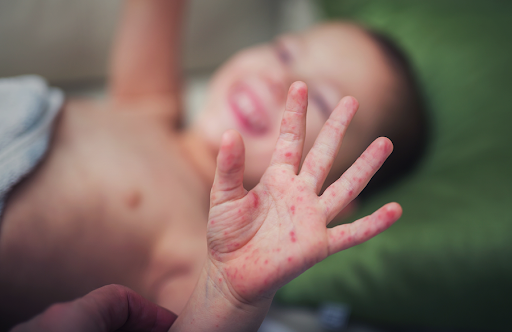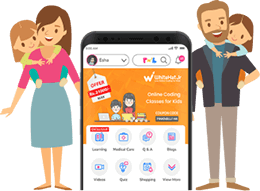Blogs
Understanding Hand Foot And Mouth Disease Symptoms And Treatment (hfmd)

Every living being evolves, and so do viruses. Battling infections like warriors, our kids are developing their natural immunity. Recently the focus has been on Hand, foot and mouth disease (HFMD). Even if your child has not gone through it, you must be hearing this word around.
Most schools have already developed a protocol for managing HFMD. But as a parent, you are the first line of defence and manager, it is essential to know in and out about this viral infection prevalent among kids.
What is HFMD?
It is a common children's virus that affects the mouth, hands and feet (hence the name - HFMD). The virus causes sores in the mouth and boils or blisters on the hand and feet. It is highly contagious and can affect people of all ages, but prominently occurs in children under 5 years of age.
The most high-contagious seasons are summer and fall.
Schools are a perfect setting for this virus to transmit. But as the severity is very low, parents need not panic. You need to be vigilant and should not send the child to school at all if one or more symptoms are showing up.
Keep reading to understand and identify the symbols.
Symptoms Of HFMD
The onset is followed by a different set of symptoms. The incubation period - the time from getting infected till symptoms start showing up, is about 3 to 4 days. It is usually a self-curable disease and
The early symptoms
- Fever - It might or might not develop at all.
- Sore throat/ mouth ulcers - You might notice your child complaining the food is spicy even for regular food or is having trouble swallowing food. Mostly occur on the sides and back of the tongue.
- Crankiness more than usual.
- Loss of appetite - It is usually due to sores that make eating painful hence kids tend to avoid eating.
- Fatigue - General lethargy than their regular activeness.
- General feeling unwell.
Other symptoms, more prominent ones, follow 2 to 3 days after the above.
- Sores around the butt, elbow, and knees can be easily confused with mosquito or insect bites. It is nothing to be scared of but can be painful for the child.
- Drooling. Due to mouth sores, drooling increases.
- Red Rashes on hands and the soles of feet.
HFMD Transmission Modes
Like any virus, it spreads from person to person or touching contaminated surfaces. The virus spreads through the fluid in the form of
- Saliva - by actions of Kissing, hugging, sharing utensils,
- Mucus - by sneezing or coughing,
- Discharge - from blisters, sores, boils and,
- Poop - like changing diapers or improper hygiene.
Preventions and Precautions
HFMD is most contagious in the first 7 to 10 days from the start of illness. It is easily transmissible from one person to another in closed environment settings like schools, daycare, groups classes or larger families. To prevent its spread, it is our responsibility as parents to ensure the following protocols.
Wash hands carefully every time and frequently, especially after changing a diaper or wiping their nose and mouth. Teach the same to the kids, to wash hands regularly.
- It is imminent to teach the kids to cover their mouth and nose when they sneeze or cough. Using a tissue or handkerchief is great, but in an unforeseen situation, sneezing in the sleeve or elbow is also good enough.
- Regularly clean surfaces and shared items like toys and doorknobs, washroom surfaces etc.
- Avoid hugging or kissing a person infected with HFMD.
- Do not share utensils, sippers, or bottles.
- Most Important - Please do not send your child to school or any places where they can come in contact with other people until their symptoms are gone and the doctor also approves. Even though the symptoms might have been cured, it remains contagious long after. Therefore your child can still infect others.
Treatments and Care
About after a week of showing symptoms, the child should feel better, even if all the blisters haven't fallen out.
But there are a few things to be taken care of at all times during the whole HFMD episode.
- Hydration - The child will refuse to eat or drink due to painful sores in the mouth. Make sure they stay well hydrated by Making them drink non-irritating bland yet tasty juices and liquids. If the pain doesn't let the child take fluids also, you should visit your doctor.
- Age - If your Child is below 6 months of age, then you should visit a doctor with the first sign of any illness.
- Immunity - Some children with low immune systems should be treated from the first day itself as a lower immune system cannot fight the virus and lead to complications like Meningitis or Encephalitis.
You can take care of your child and offer comfort food or fluids to maintain hydration. Limit intake of spicy or citrus food, as they can irritate the lining inside the mouth and aggravate the sores. If the symptoms are worrying, do not wait for home remedies and treatment and immediately consult with your paediatrician.
For pain and fever, the doctor can prescribe over-the-counter medicines. There is no specific treatment for HFMD. It resolves on its own in a few days.
Breaking Myths
With the disease itself, there is a myth that is also doing rounds. Please do not believe everything you hear or read, and confirm from your paediatrician. Here are some myths that we are busting for you.
- HFMD can occur in adults too. - True
- It's a Disease with a specific treatment - False
- HFMD can happen once in a lifetime - False
- HFMD blisters occur only on hands, feet and mouth - False (read symptoms above)
Always feel free to ask your doctor any doubt. Be an alert parent and prevent transmission as much as possible.
Love this blog? Share it with other parents.





